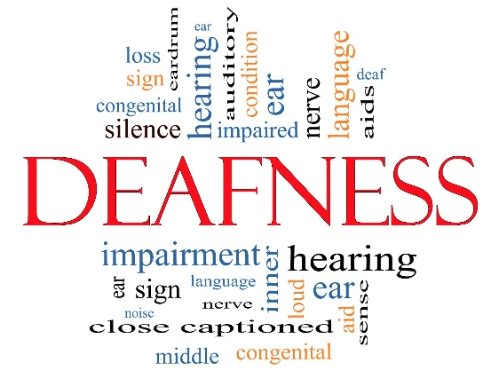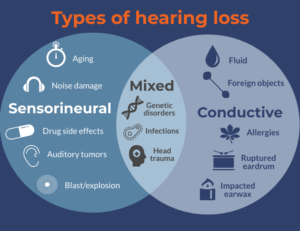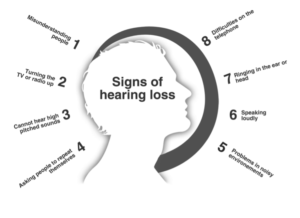
Table of Contents
What is Deafness and Hearing Loss?
- Deafness and hearing loss is the inability or reduced ability of a person to hear properly.
- Deafness and hearing loss are primarily the problems related to ear or hearing.
- Deafness and hearing loss is a condition where a person cannot hear the voice or sound as perfectly as a normal person should be hearing i.e., hearing thresholds of 20 dB or better in both ears.
What is Deafness?
- The total inability to hear sound is known as deafness.
- Deafness happens when a person is unable to perceive speech through hearing, even when sound is amplified.
- People who identify as “deaf” typically have substantial hearing loss, which indicates little to no hearing. They frequently communicate by sign language.
What is Hearing Loss?
- Reduced ability to hear sounds in the same way as other people is known as hearing loss.
- Hearing loss is the inability to hear as perfectly as someone with normal hearing- defined as hearing thresholds of 20 dB or better in both ears.
- The severity of a hearing loss might range from mild to severe. It makes it difficult to hear conversational dialogue or loud noises and can affect one or both ears.
Different Levels of Deafness
1. Mild deafness or mild hearing impairment
- Only sounds between 25 and 29 decibels(dB) can be heard by the individual
- If there is a lot of background noise, they could have trouble understanding what other people are saying.
2. Moderate deafness or moderate hearing impairment
- The range of sounds that the person can hear is only 40 to 69 dB.
- Without a hearing aid, it is extremely difficult to follow a conversation.
3. Severe deafness
- Only sounds between 70 and 89 dB are audible to the individual.
- Even with a hearing aid, a person who is severely deaf must lip-read or use sign language to communicate.
4. Profound deafness
- Anyone who is profoundly deaf is unable to hear sounds that are 90 dB or less.
- Some persons who have profound deafness are completely deaf and cannot hear anything at any volume.
- Reading and writing, lip-reading, and sign language are all used for communication.
Types of Hearing Loss

1. Conductive hearing loss
- When sound cannot enter the inner ear, it’s called conductive hearing loss.
- It is typically brought on by an obstruction, deformity, or damage in the outer or middle ear, such as microtia.
2. Sensorineural hearing loss
- A disorder with the auditory nerve, which transmits sound to the brain, or the inner ear, causes sensorineural hearing loss.
3. Mixed hearing loss
- It means the hearing loss is being caused by a combination of the two.
Causes of Deafness and Hearing loss (during different stages of life)
Prenatal Period
- Genetic factors – Include hereditary and non-hereditary hearing loss
- Intrauterine infections – such as rubella and cytomegalovirus infection
Perinatal period
- Birth asphyxia (a lack of oxygen at the time of birth
- Hyperbilirubinemia (severe jaundice in the neonatal period)
- Low-birth weight
- Other perinatal morbidities and their management
Childhood and adolescence
- Chronic ear infections (chronic suppurative otitis media)
- Collection of fluid in the ear (chronic nonsuppurative otitis media)
- Meningitis and other infections
Adulthood and older age
- Chronic diseases
- Smoking
- Otosclerosis
- Age-related sensorineural degeneration
- Sudden sensorineural hearing loss
Factors across the life span
- Cerumen impaction (impacted ear wax)
- Trauma to the ear or head
- Loud noise/loud sounds
- Ototoxic medicines
- Work related ototoxic chemicals
- Nutritional deficiencies
- Viral infections and other ear conditions
- Delayed onset or progressive genetic hearing loss
Warning Signs of Deafness and Hearing Loss

- Voices sound muffled or unclear
- Can’t follow the conversation in noisy places
- Exhausted after social events
- Watching people’s lips instead of making eye contact
- Ears feel clogged
- The volume on TV keeps creeping up
Diagnosis of Deafness and Hearing Loss
- A healthcare provider will do several different types of tests to identify deafness and hearing loss.
- These tests evaluate hearing capacity and the efficiency with which the ear’s parts communicate with the brain.
- A hearing test could involve playing certain tones and monosyllabic (single-syllable) words through headphones while excluding other noises.
- In other tests, sensors may be affixed to the head to gauge how well the auditory nerve and brain stem react to the sounds coming from the headphones.
Impact of Unaddressed Deafness and Hearing Loss
- Hearing loss can have a big impact on a lot of different aspects of a person’s life, including their level of social participation and their ability to maintain interpersonal and professional relationships.
- However, many people discover they can manage well and that their quality of life increases when hearing loss is treated effectively.
- Hearing loss affects many aspects of one’s life on an individual basis when left untreated.
- Children who are deaf or have hearing loss frequently do not attend school in poor nations.
- Additionally, the unemployment rate for adults with hearing loss is substantially greater.
- In comparison to the general population, a higher proportion of those with hearing loss are working in lower levels of employment.
Preventive Measures from Deafness and Hearing Loss
- Nearly 60% of hearing loss in children is caused by preventable conditions that can be avoided with the implementation of public health interventions.
- Similar to children, adults may avoid the majority of causes of hearing loss, including exposure to loud noises and ototoxic drugs.
- Effective methods for preventing hearing loss at various stages of life include:
- Immunization
- Good maternal and child rearing practices
- Genetic counseling
- Early diagnosis and treatment of common ear conditions
- Occupational hearing conservation programs for noise and chemical exposure
- Safe listening techniques for reducing exposure to loud sounds in recreational settings
- Prudent use of medications to prevent ototoxic hearing loss
Treatment of Deafness and Hearing Loss
- Removing wax blockage
- Surgical procedures
- Hearing aids
- Cochlear implants
WHO Response
- Help member States to raise awareness of Ear and Hearing Care issues
- Promote the collection and dissemination of data and information about ear and hearing care
- Supplying technical tools and guidance to help with planning and improving the capacity of health systems for ear and hearing care
- Supporting ear and hearing care workforce training
- Through the WHO Make Listening Safe campaign, safe listening is encouraged to lower the risk of recreational noise-induced hearing loss;
- World Hearing Day is celebrated and promoted as an annual advocacy event;
- Establishing collaborations to create effective hearing care programs, including programs for inexpensive hearing aids, cochlear implants, and services;
- Promoting ear and hearing health via the World Hearing Forum.
References and For More Information
https://www.ndcs.org.uk/information-and-support/childhood-deafness/what-is-deafness/levels-of-deafness/
https://www.who.int/news-room/fact-sheets/detail/deafness-and-hearing-loss
https://raisingchildren.net.au/disability/guide-to-disabilities/assessment-diagnosis/hearing-impairment
https://medbroadcast.com/condition/getcondition/hearing-loss-and-deafness
https://www.medicalnewstoday.com/articles/249285#types
https://www.webmd.com/connect-to-care/hearing-loss/hearing-loss-versus-deaf
https://www.healthline.com/health/hard-of-hearing#_noHeaderPrefixedContent
https://www.ncbi.nlm.nih.gov/books/NBK279527/